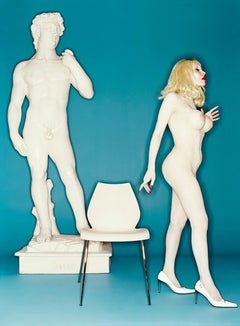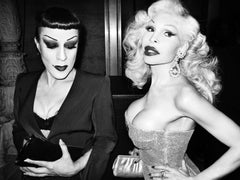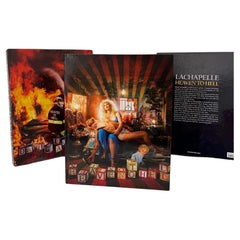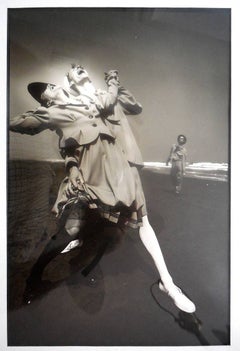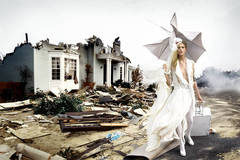Amanda Lepore
Early 2000s Modern Portrait Photography
C Print
1980s Contemporary Black and White Photography
Archival Pigment
21st Century and Contemporary American Expressionist Books
Paper
1980s Conceptual Figurative Photography
Silver Gelatin
Recent Sales
Early 2000s Modern Color Photography
C Print
21st Century and Contemporary Contemporary Figurative Photography
C Print
1980s 85 New Wave Figurative Photography
Silver Gelatin
1980s 85 New Wave Figurative Photography
Silver Gelatin
1980s Conceptual Figurative Photography
Silver Gelatin
1980s 85 New Wave Figurative Photography
Silver Gelatin
1980s 85 New Wave Figurative Photography
Silver Gelatin
Early 2000s Modern Color Photography
Archival Paper
David LaChapelle"Tool Time Pam Anderson" Original Limited Edition#33 of 75 by David LaChapelle, 2001
People Also Browsed
2010s South African Minimalist Pedestals
Hardwood
1970s American Modern Nude Photography
Silver Gelatin
21st Century and Contemporary European Books
1980s Other Art Style Black and White Photography
Silver Gelatin
David LaChapelle for sale on 1stDibs
David LaChapelle's highly polished, saturated and intricately composed photographs possess the surreal wildness of fever dreams, concocted as they are out of the imagery of celebrity, eroticism and modern Americana, and spiked with religious allegory and forebodings of doom.
Such work has made him among the most influential art and celebrity photographers of his generation. You might say LaChapelle sprung straight from the head of Andy Warhol, whose campy silkscreen fusions of the glamorous, the transgressive and the everyday forever changed contemporary art.
Like so many young gay artists who came out of the 1980s downtown New York scene, LaChapelle’s escapist visions arose out of a lonely, bullied adolescence. Although born in Connecticut, the photographer spent his early childhood in North Carolina, the youngest of three children. Later, when LaChapelle was in his early teens, his family moved back to suburban Connecticut, but his cowboy costumes and gender-bending ways did not earn LaChapelle friends among his new preppy classmates.
By high school, LaChapelle felt terrorized and suicidal. He fled to New York, where his good looks got him a job bussing tables at Studio 54. It was there that he reputedly first met Warhol, who had been his favorite artist since he first gazed upon a Gold Marilyn, while on a fourth-grade field trip to a museum.
LaChapelle's parents eventually retrieved him from New York, and, sympathizing with his plight, sent him off to the North Carolina School of the Arts. Despite a more embracing atmosphere, he didn’t stay long. A sojourn in London followed. When he returned to New York, around 1983, the punk-inflected downtown culture was churning out gritty new art. Keith Haring’s gay-themed Pop-art graffiti was in everybody’s face, and Robert Mapplethorpe’s S&M photos were on gallery walls.
Having scored a show of his black-and-white photography — already vaguely campy and transfiguration-obsessed — at New York’s then-fledgling 303 Gallery in 1984, LaChapelle attracted the interest of Interview magazine. Warhol was then at the zenith of his influence in both the art world and the downtown scene. Recognizing LaChapelle’s potential as an eye-catching celebrity photographer, he put him on staff, providing him with the creative milieu where his distinctive talent might develop.
There were editorial assignments for i-D, The Face and later for Vanity Fair, Vogue Paris and Rolling Stone. He also made excursions into advertising. One of his most talked about campaigns was a provocative print ad for Diesel jeans inspired by the famous photograph of the V-J kiss in Times Square, but this time showing Tom of Finland–type sailors in passionate embrace.
After being without an editorial home for several years, LaChapelle finally found a base at Details, where he was again encouraged to let his freak flag fly. So arresting were his images that it wasn’t long before “the Fellini of photography,” as New York magazine dubbed him in 1996, was again working for Interview. One of his most emblematic pictures from this era was a Lil’ Kim cover for that magazine, featuring the rapper’s nude body emblazoned with Louis Vuitton insignia (one of the most famous logos in luxury fashion).
Such visually zany, socially astute portraits prompted Richard Avedon to liken LaChapelle to a photographic Magritte, while also winning him invitations to direct music videos for such talents as Christina Aguilera, Moby and Amy Winehouse.
Find a collection of original David LaChapelle photography today on 1stDibs.
Finding the Right Photography for You
Find a broad range of photography on 1stDibs today.
The first permanent image created by a camera — which materialized during the 1820s — is attributed to Joseph Nicéphore Niépce. The French inventor was on to something for sure. Kodak introduced roll film in the 1880s, allowing photography to become more democratic, although cameras wouldn’t be universally accessible until several decades later.
Digital photographic techniques, software, smartphone cameras and social-networking platforms such as Instagram have made it even easier in the modern era for budding photographers to capture the world around them as well as disseminate their images far and wide.
What might leading figures of visual art such as Andy Warhol have done with these tools at their disposal?
Today, when we aren’t looking at the digital photos that inundate us on our phones, we look to the past to celebrate the photographers who have broken rules as well as records — provocative and prolific artists like Horst P. Horst, Lillian Bassman and Helmut Newton, who altered the face of fashion and portrait photography; visionary documentary photographers such as Gordon Parks, whose best-known work was guided by social justice; and pioneers of street photography such as Henri Cartier-Bresson, who shot for revolutionary travel magazines like Holiday with the likes of globetrotting society lensman Slim Aarons.
Find photographers you may not know in Introspective and The Study — where you’ll read about Berenice Abbott, who positioned herself atop skyscrapers for the perfect shot, or “conceptual artist-adventurer” Charles Lindsay, whose work combines scientific rigor with artistic expression, or Massimo Listri, known for his epic interiors of opulent Old World libraries. Photographer Jeannette Montgomery Barron was given a Kodak camera as a child. Later, she shot on Polaroid film before buying her first 35mm camera in her teens. Barron's stunning portraits of Jean-Michel Basquiat, Warhol and other artists chronicle a crucial chapter of New York’s cultural history.
Throughout the past two centuries, photographers have used their medium to create expressive work that has resonated for generations. Shop a voluminous collection of this powerful fine photography on 1stDibs. Search by photographer to find the perfect piece for your living room wall, or spend some time with the work organized under various categories, such as landscape photography, nude photography and more.
